Web Programming Step by Step, 2nd Edition
Lecture 27: Web Security
Reading: Ch. 15
Except where otherwise noted, the contents of this document are Copyright 2012 Marty Stepp, Jessica Miller, and Victoria Kirst. All rights reserved. Any redistribution, reproduction, transmission, or storage of part or all of the contents in any form is prohibited without the author's expressed written permission.
Our current view of security

- until now, we have assumed:
- valid user input
- non-malicious users
- nothing will ever go wrong
- this is unrealistic!
The real world

- in order to write secure code, we must assume:
- invalid input
- evil users
- incompetent users
- everything that can go wrong, will go wrong
- everybody is out to get you
- botnets, hackers, script kiddies, KGB, etc. are out there
- the security mindset: assume nothing; trust no one
Attackers' goals

Why would an attacker target my site?
- Read private data (user names, passwords, credit card numbers, grades, prices)
- Change data (change a student's grades, prices of products, passwords)
- Spoofing (pretending to be someone they are not)
- Damage or shut down the site, so that it cannot be successfully used by others
- Harm the reputation or credibility of the organization running the site
- Spread viruses and other malware
Tools that attackers use
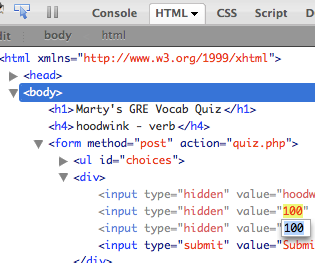
Assume that the attacker knows about web dev and has the same tools you have:
- Firebug
- extensions e.g. Web Dev Toolbar
- port scanners, e.g. nmap
- network sniffers, e.g. Wireshark, EtherDetect, Firesheep
Some kinds of attacks

- Denial of Service (DoS): Making a server unavailable by bombarding it with requests.
- Social Engineering: Tricking a user into willingly compromising the security of a site (e.g. phishing).
- Privilege Escalation: Causing code to run as a "privileged" context (e.g. "root").
- Information Leakage: Allowing an attacker to look at data, files, etc. that he/she should not be allowed to see.
- Man-in-the-Middle: Placing a malicious machine in the network and using it to intercept traffic.
- Session Hijacking: Stealing another user's session cookie to masquerade as that user.
- Cross-Site Scripting (XSS) or HTML Injection: Inserting malicious HTML or JavaScript content into a web page.
- SQL Injection: Inserting malicious SQL query code to reveal or modify sensitive data.
Information leakage
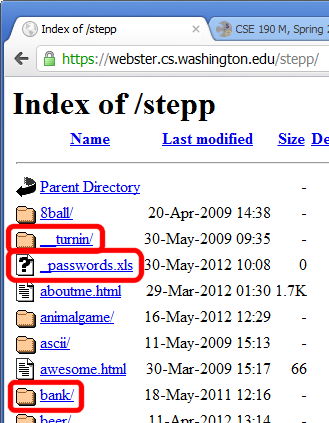
when the attacker can look at data, files, etc. that he/she should not be allowed to see
-
files on web server that should not be there
- or have too generous of permissions (read/write to all)
-
directories that list their contents (indexing)
- can be disabled on web server
-
guess the names of files, directories, resources
- see
loginfail.php, tryloginsuccess.php - see
user.php?id=123, tryuser.php?id=456 - see
/data/public, try/data/private
- see
Man-in-the-middle attack
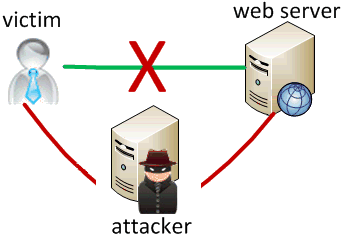
when the attacker listens on your network and reads and/or modifies your data
- works if attacker can access and compromise any server/router between you and your server
- also works if you are on the same local area network as the attacker
- often, the attacker still sends your info back and forth to/from the real server, but he silently logs or modifies some of it along the way to his own benefit
- e.g. listens for you to send your user name / password / credit card number / ...
Secure HTTP (HTTPS)
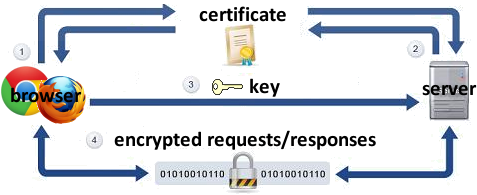
- HTTPS: encrypted version of HTTP protocol
- all messages between client and server are encrypted so men in the middle cannot easily read them
- servers can have certificates that verify their identity
Session hijacking

when the attacker gets a hold of your session ID and masquerades as you
-
exploit sites that use HTTPS for only the initial login:
- HTTPS: browser → server (POST login.php)
- HTTPS: browser ← server (login.php + PHPSESSID cookie)
- HTTP: browser → server (GET whatever.php + PHPSESSID cookie)
- HTTP: browser ← server (whatever.php + PHPSESSID cookie)
- attacker can listen to the network, get your session ID cookie, and make requests to the same server with that same session ID cookie to masquerade as you!
- example: Firesheep
HTML injection
a flaw where a user is able to inject arbitrary HTML content into your page

- This flaw often exists when a page accepts user input and inserts it bare into the page.
- example: magic 8-ball (8ball.html)
- What kinds of silly or malicious content can we inject into the page? Why is this bad?
Injecting HTML content
8ball.php?question=<em>lololol</em>
- injected content can lead to:
- annoyance / confusion
- damage to data on the server
- exposure of private data on the server
- financial gain/loss
- end of the human race as we know it
- why is HTML injection bad? It allows others to:
- disrupt the flow/layout of your site
- put words into your mouth
- possibly run malicious code on your users' computers
Cross-site scripting (XSS)
a flaw where a user is able to inject and execute arbitrary JavaScript code in your page
8ball.php?question=<script type='text/javascript'>alert('pwned');</script>
- JavaScript is often able to be injected because of a previous HTML injection
-
Try submitting this as the 8-ball's question in Firefox:
-
<script type="text/javascript" src="http://panzi.github.com/Browser-Ponies/basecfg.js" id="browser-ponies-config"></script><script type="text/javascript" src="http://panzi.github.com/Browser-Ponies/browserponies.js" id="browser-ponies-script"></script><script type="text/javascript">/* <![CDATA[ */ (function (cfg) {BrowserPonies.setBaseUrl(cfg.baseurl);BrowserPonies.loadConfig(BrowserPoniesBaseConfig);BrowserPonies.loadConfig(cfg);})({"baseurl":"http://panzi.github.com/Browser-Ponies/","fadeDuration":500,"volume":1,"fps":25,"speed":3,"audioEnabled":false,"showFps":false,"showLoadProgress":true,"speakProbability":0.1,"spawn":{"applejack":1,"fluttershy":1,"pinkie pie":1,"rainbow dash":1,"rarity":1,"twilight sparkle":1},"autostart":true}); /* ]]> */</script>
-
- injected script code can:
- masquerade as the original page and trick the user into entering sensitive data
- steal the user's cookies
- masquerade as the user and submit data on their behalf (submit forms, click buttons, etc.)
- ...
Securing against HTML injection / XSS
- one idea: disallow harmful characters
- HTML injection is impossible without < >
- can strip those characters from input, or reject the entire request if they are present
- another idea: allow them, but escape them
htmlspecialchars
|
returns an HTML-escaped version of a string |
$text = "<p>hi 2 u & me</p>";
$text = htmlspecialchars($text); # "<p>hi 2 u & me</p>"
Another XSS example
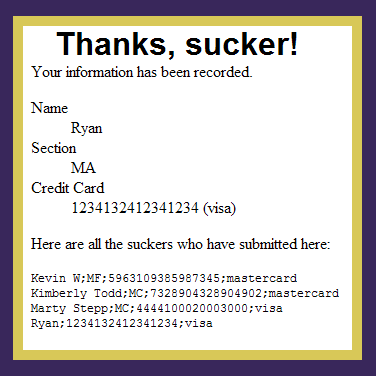
- example: Lab 4, Buy-a-Grade (buyagrade.html)
- Recall that the user submits his name, section, and credit card number to the server, which are then displayed on the page.
- How can we inject HTML/JavaScript into the page? Be creative...
- What could we do to steal the user's sensitive information?
SQL injection

a flaw where the user is able to inject arbitrary SQL into your query
- This flaw often exists when a page accepts user input and inserts it bare into the query.
- example: simpsons grade lookup (start.php)
- What kinds of SQL can we inject into the query? Why is this bad?
A SQL injection attack
-
The query in the Simpsons PHP code is:
$query = "SELECT * FROM students WHERE username = '$username' AND password = '$password'";
- Are there malicious values for the user name and password that we could enter?
- Password:
-
This causes the query to be executed as:
$query = "SELECT * FROM students WHERE username = '$username' AND password = '' OR '1'='1'";
- What will the above query return? Why is this bad?
Too true...

- injected SQL can:
- change the query to output others' data (revealing private information)
- insert a query to modify existing data (increase bank account balance)
- delete existing data (
; DROP TABLE students; --) - bloat the query to slow down the server (
JOIN a JOIN b JOIN c ...) - ...
Securing against SQL injection
- similar to securing against HTML injection, escape the string before you include it in your query
quote
|
returns a SQL-escaped version of a string |
$username = $db->quote($_POST["username"]); $password = $db->quote($_POST["password"]); $query = "SELECT name, ssn, dob FROM users WHERE username = $username AND password = $password";
- replaces
'with\', etc., and surrounds with quotes
Practice problem: Hack turnin page
-
How can we break this
turnin page?
- Our enemy is classmate Felix Chu, from section AD. We want to steal his personal info (password, email, student ID, grade, etc.).
- Let's also find a way to make sure that Felix will get a low score on Homework 7.
-
We want to cheat on Homework Assignment 7,
Song.java. We want to find a way to submit a perfect working solution without doing any real work.
Breaking the turnin page
-
Discover/overwrite the teacher's solution by submitting with an invalid section.
Then submit as
steppwith section ofSOLUTIONto see the working solution. - Steal Felix's personal info by looking at the directory index and finding students.txt.
- Give Felix a low score on HW7 by turning in a bad solution to the HW using his name / email, overwriting his past submission.
-
BONUS: The
fetch_help.phpcan be used to read arbitrary files: example

